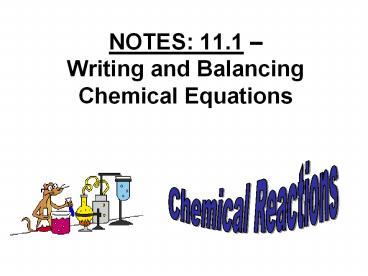NOTES: 11.1 PowerPoint PPT Presentation
1 / 21
Title: NOTES: 11.1
1
NOTES 11.1 Writing and Balancing Chemical
Equations
Chemical Reactions
2
Effects of chemical reactions
- Chemical reactions rearrange atoms in the
reactants to form new products. - The identities and properties of the products
are completely different from that of the
reactants.
3
What is a Chemical Reaction?
- Chemical Reaction one or more substances
change into new substances - Process involves reactants and products
- Reactant a starting substance
- Product a substance formed
- Example
- Nitrogen and hydrogen gas can react to form
ammonia under certain conditions. - Reactants Yield
Products - N2 (g) H2 (g) ? NH3 (g)
4
How Can You Tell Whether or Not a Chemical
Reaction Has Taken Place?
- Chemical Change alters a given material by
changing its chemical composition - Production of gases and color changes are signs
of chemical reactions - Examples burn, rust, decompose, corrode,
explode
5
Chemical Reactions
- we can describe a chemical reaction with words
- Iron metal reacts with oxygen gas to produce
iron(III) oxide, or rust. - we can then write a word equation
- Iron oxygen ? iron(III) oxide
6
Chemical Equations
Chemical equations are used to represent or
describe chemical reactions. Chemical
equations use chemical symbols and formulas for
the reactants and products For example when
hydrogen, H2,burns, it reacts with oxygen, O2, in
the air to form water. We write the chemical
equation for this reaction as follows
2H2 O2 ? 2H2O
7
Chemical Equations
An equation shows ? Chemical formulas of
reactants ? Chemical formulas of products ?
Molecule / Mole ratios of all compounds in the
reaction.
8
Chemical Equations
We read the () sign as reacts with and the
arrow (? ) as produces or yields. 2H2 O2
? 2H2O
Reactants
Products
9
To show physical states of each substance
- (s) solid
- (l) liquid
- (g) gas
- (aq) aqueous
- aqueous means dissolved in water
10
- Consider again the reaction of iron with oxygen
to form iron(III) oxide, or rust. - Fe(s) O2 (g) ? Fe2O3 (s)
- (unbalanced)
- this is a skeleton equation in that is NOT
balanced and does not show the relative amounts
of reactants and products
11
Coefficients Subscripts
COEFFICIENTS numbers in front of compound that
represents the number of molecules/moles of that
compound SUBSCRIPTS small numbers within a
formula that help define the compound. 2H2SO4
Subscript
Coefficient
12
H2O One molecule of water 2H2O Two molecules
of water H2O2 One molecule of Hydrogen Peroxide
13
During a chem. rxn. atoms are rearranged (NOT
created or destroyed!) Chemical equations must
be BALANCED to show the relative amounts of all
substances. Balanced means each side of the
equation has the same of atoms of each
element. CH4 O2 ? H2O CO2 Unbalanced CH
4 2O2 ? 2H2O CO2 Balanced
14
In order to balance
- Write correct formulas for all reactants and
products - Reactants ? Products
- Count the number of atoms of each element in
reactants products. - Balance one at a time using coefficients.
- Check for balance
- Are the coefficients in the lowest possible
ratio?
15
Balancing Equations
NOTE When balancing equations, you may change
coefficients as much as you need to, but you may
never change subscripts because you cant change
what substances are involved.
16
- Fe(s) O2(g) ? Fe2O3(s) (unbalanced)
- 4Fe(s) 3O2(g) ? 2Fe2O3(s) (balanced)
17
Sample Problem 1
- ? Water is decomposed (broken down) to form the
gaseous products hydrogen, H2, and oxygen, O2.
Write the balanced equation for this reaction. - ? H2O ? H2 O2
- O is not balanced
- ? 2H2O ? 2H2 O2
- The equation is balanced!
18
Sample Problem 2
- ? Chlorine gas, Cl2, reacts with potassium
bromide, KBr, to form potassium chloride and
bromine, Br2. Write the balanced equation for
this reaction, - ? Cl2 KBr ? KCl Br2
- Cl and Br are not balanced
- ? Cl2 2KBr ? 2KCl Br2
- The equation is balanced!
19
Examples
- CuCl2 (aq) Al (s) ? Cu (s) AlCl3 (aq)
- 3CuCl2 (aq) 2Al (s) ? 3Cu (s) 2AlCl3 (aq)
- (3232)
20
Examples
- Propane, C3H8, burns in oxygen, O2, to form
carbon dioxide and water. - C3H8 O2 ? CO2 H2O
- Balance C then H then O
- C3H8 5O2 ? 3CO2 4H2O
- (1534)
21
Examples
- Pentane, C5H12, burns in oxygen, O2, to form
carbon dioxide and water. - C5H12 O2 ? CO2 H2O
- Balance C then H then O
- C5H12 8O2 ? 5CO2 6H2O
- (1856)
22
Examples
- Silver nitrate reacts with copper to produce
silver and copper (II) nitrate. - AgNO3 Cu ? Ag Cu(NO3)2
- 2AgNO3 Cu ? 2Ag Cu(NO3)2
- (2121)
23
Examples
- Phosphorus reacts with oxygen gas to produce
diphosphorus pentoxide. - P O2 ? P2O5
- 4P 5O2 ? 2P2O5
- (452)
24
Examples
- C7H14 O2 ? CO2 H2O
- Balance C then H then O
- C7H14 10½O2 ? 7CO2 7H2O
- 2C7H14 21O2 ? 14CO2 14H2O
- (2211414)

